The Tokyo Zodiac Murders (21 page)
Read The Tokyo Zodiac Murders Online
Authors: Soji Shimada

“But,” I interrupted him, “if Taeko wanted to make all the murders look like they had one male perpetrator, why did she bother to ransack Kazue’s house?”
“She wanted to make the case look unrelated to Heikichi’s murder,” Kiyoshi replied. “She needed things to look as though both a burglary and a sexual assault had taken place. Otherwise, the police would have gone over the house with a fine-tooth comb and found the bodies of the girls in storage. However, she made another amateurish mistake: she left Kazue dressed very neatly in her kimono despite all that had supposedly happened to her. That made me curious. Besides, Taeko’s basic plan was to frame Masako for the Azoth murders. Making it seem that a man killed Kazue would effectively clear the way for Masako to be accused of killing the six Umezawa girls.
“But the risk of keeping the girls’ bodies at Kazue’s house was still high. Therefore, Taeko had to force Mr Takegoshi to dispose of the bodies immediately. She was lucky, because rural police investigations then were very slow and unsophisticated. Her trick wouldn’t work today; criminal investigation is much more advanced and precise. The same thing can be said about the newspapers. The printing of Kazue’s photo was so bad that Mr Takegoshi couldn’t be certain that she was not the woman he’d had sex with.
“Now, Kazue’s blood was cleaned off the vase that was used as the murder weapon. Taeko then set the vase in a place where Mr Takegoshi would be sure to see it, imprinting it in his memory, so that he would think that the murder occurred
after
his visit. Knowing that the vase was the murder weapon would also raise his level of fear.
“Kazue was killed while facing the mirror. She didn’t try to
run away and she didn’t put up a struggle, implying that the victim knew the killer. After she bludgeoned Kazue to death, Taeko also carefully wiped the blood off the mirror, and moved Kazue’s body to the adjacent room. Why Taeko killed Kazue in her home is not clear, but women looking into a mirror can be caught off-guard. Either Taeko planned it this way or something occurred between her and Kazue to trigger the violence. I’m a man, so I can only imagine what was on Taeko’s mind at that moment. One of her motives may have been a deep-seated grudge towards Kazue, but let’s explore the motive later.
“As regards the murder of the Umezawa girls, I think Taeko killed them when they were all together at Kazue’s house. It was remote and it was convenient; she could poison them at once, store the bodies and then cut them up. In the larger picture, Kazue’s murder was merely a stepping stone for the Azoth murders.”
Kiyoshi paused again, and sipped some more coffee.
“Now, the Azoth murders. These serial murders have bedevilled and fascinated this country just as if they were indeed an excellent magic show. When I heard of this case for the first time, I might have sensed that the key was magic, but I did not fully comprehend what it was all about and so I kept overlooking the core of the mystery. But yesterday I happened to recall a magic trick. As a result, I quickly solved the case, and two hours later I was able to meet the culprit.
“The trick itself was so simple that no one ever thought of it being used in this case. But many policemen will remember it, I’m sure. It was a technique for committing fraud with ten-thousand-yen bills that was mainly used in the Kansai area some years ago. I remember that a television news programme
I was watching in a restaurant reported it something like this: ‘A ten-thousand-yen bill was found today with a missing part that had been covered up with opaque tape. The bill had been cut and taped together, so the bill was not quite as long as a normal ten-thousand-yen bill, and the serial numbers on the right side and left side didn’t match. Investigators suspect fraud. It is the first case of fraud using this technique that has come to light in Tokyo.’ Perhaps to prevent copycat fraud, the news did not explain any further. In fact, the young people at the next table to me in the restaurant immediately started wondering how they could make some money by cutting up bills! Since you may not be sure how it is done, allow me to demonstrate.”
Kiyoshi turned to the blackboard and drew a series of rectangles.
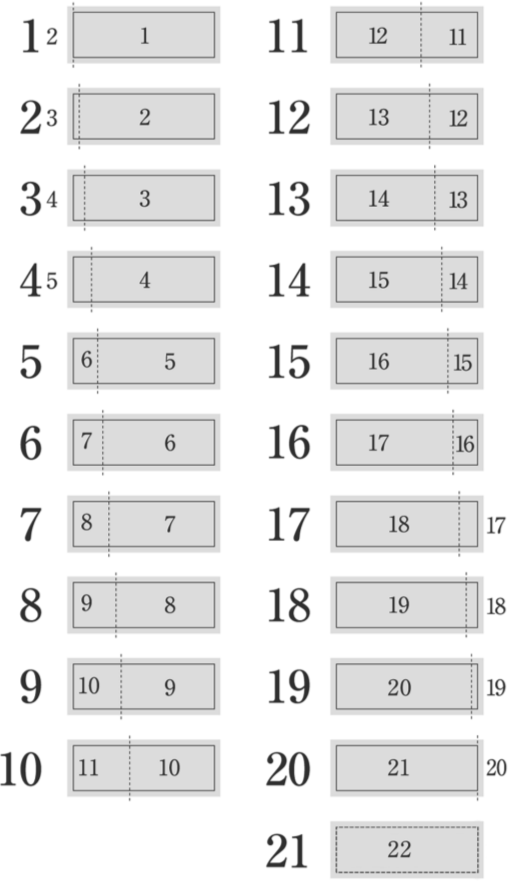
“Here are twenty bills. Ten bills might do, but the risk of detection is too high because of the size of the missing parts. The safest way would be to use thirty bills, but that might hurt your profit margin! Twenty is about right. Now on each bill we draw a line, like this. Starting with the first bill, the distance of the line from the left edge increases incrementally. By the time we come to the last bill, the line reaches almost to the right edge. Then with a pair of scissors we cut each bill along the line drawn. We now have twenty bills cut into forty pieces.
“So that the exact operation is clear, I’ll label each piece in this way, with L representing the left side of the bill and R the right: like this, 1L, 1R, 2L, 2R, and so on… This is where the magic—or the fraud, depending on your point of view—begins.
“All twenty bills have been cut in this pattern—with, as I said, the left side of the bill getting wider and wider until, finally, it makes up almost the entire bill and there is only a very narrow strip remaining on the right side. From bill #1, we put aside 1R, the slightly shortened right side of the bill. Then we take the narrow strip cut from the left side, 1L, and attach it—with opaque tape—to 2R, the right side of bill #2… We take the left side of bill #2, which is labelled as 2L, and attach it to 3R, the right side of bill #3… and so on, and so on. Finally we attach 19L to 20R, and save 20L as a slightly small bill, just like 1R. As you can see, we are left with what appear to be 21 ten-thousand-yen bills! The first and last bills will look severed, but if a cashier doesn’t check carefully, we have succeeded. We have fabricated one new bill with the help of scissors and tape; it must be opaque tape to obscure what has been done.
“This technique for committing fraud gave me the key to this mystery. I realized that the killer had applied the same technique to the bodies. We believed that there were
six
victims in the Azoth murders, and we never doubted it. In fact, it only looked like there were six. In reality, there were only
five!
”
I uttered a cry of astonishment.
So it was all an illusion! Azoth never existed. She was like a mirage.
I was too dizzy to think. I could barely sit still. I had come out in goosebumps.
Mrs Iida and her detective husband seemed dumbfounded, too. The three of us stared at Kiyoshi, eager to hear his next revelation.
“Now, of course, body parts can’t be stuck together with opaque tape,” Kiyoshi continued with a tone of detachment. “Therefore, Taeko needed something that would work like glue. The concept of Azoth was so grotesque in itself that the thought of mixing and matching the body parts of different girls never entered anyone’s mind. Everybody assumed that the missing head had been used for Azoth, the perfect woman of supreme beauty. The image of her mysterious smile has held people in thrall for forty years, as if the art of the Renaissance painter was the trick. In this case, the killer used perspective to draw the perfect picture of the murders. But Azoth existed only at the vanishing point. Nobody ever considered the possibility that the girl whose head was missing could be still alive. That’s right—Azoth was never created, even in the killer’s mind; moreover, she was never meant to exist.
“Well, I’m sure you can untangle the rest of the mystery yourselves. Thank you for listening.”
For a moment, the three of us sat there, stupefied.
Then I shouted out, “Wait! You can’t stop now!”
I had more questions than I knew how to ask. Kiyoshi, who was feigning boredom, simply grinned. He took his time sipping his coffee.
I was still totally bewildered. I felt as if I was standing in a forest surrounded by hundreds of trees in the shape of question marks. My emotions generated a storm that shook the trees, the questions came tumbling out.
“But who was the culprit? Why were some bodies buried deep and others so shallow? Did the placement of the bodies really have some connection with astrology? How were the locations designated? What does longitude 138° 48’ E signify? Was the order of discovery of the bodies important? What was the killer’s main motive? Where did she hide herself? What was the real significance of Heikichi’s note?…”
“Well, Mr Ishioka, I’m surprised you’re interested in such details!” said Kiyoshi with a smile. “You don’t usually listen to me when I say something of importance. Now it may seem that I am praising the killer—and in fact I suppose I am. Taeko Sudo pulled off the murders brilliantly; she deserves our admiration. If I were a killer, I’m sure I would have done it the same way. It’s a pity we can’t hear the explanation directly from her. But would you really like me to continue?”
Mr Iida and I nodded and Mrs Iida opened her eyes wide, urging him to go on.
Kiyoshi opened the notebook he had been drawing in earlier.
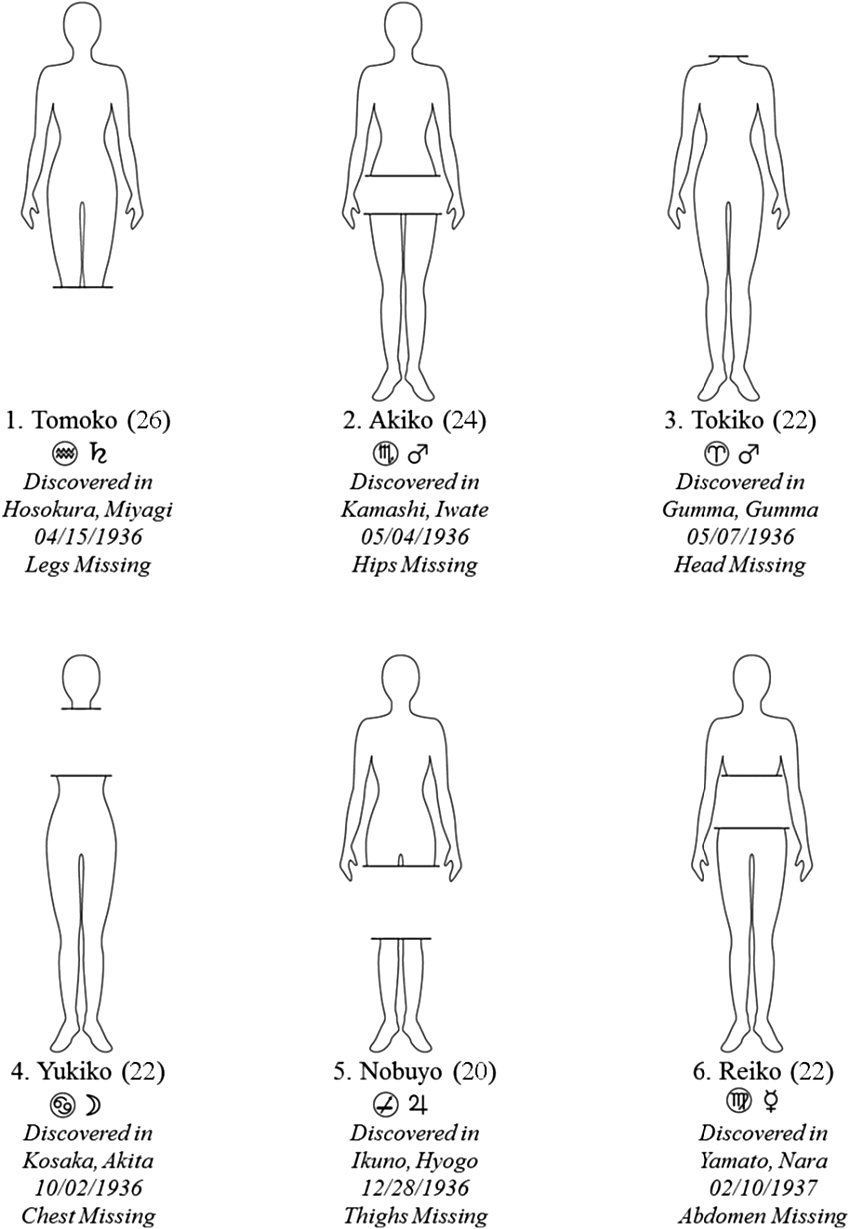
“All right, my friends, here is an illustration of the six bodies in the order they were found, starting with the one identified as Tomoko on the left. You can see I have included their personal details and also noted which parts of their bodies were missing. Just looking at this, however, it is not easy to see how the trick works—which was the whole point, of course!
“But if we arrange the six bodies in a different order, you will see how a distinct pattern emerges.” Kiyoshi went to the blackboard and drew all six bodies again as he spoke.
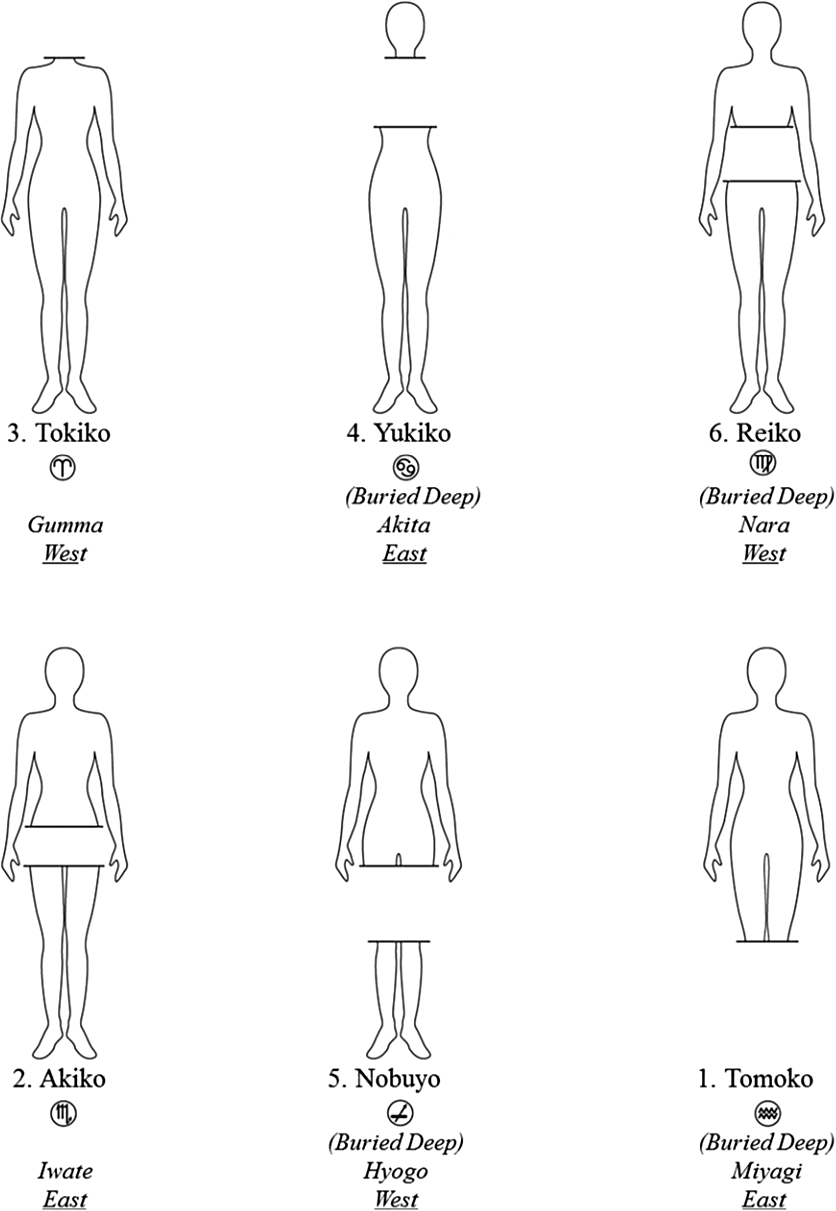
“First, on the left, let’s put Tokiko, the Aries, whose head was missing; then, Yukiko, the Cancer, whose chest was missing; then third, Reiko, the Virgo, whose abdomen was missing…
“Now please look again at my first illustration that shows the order in which the bodies were found. At the time of their discovery, as you will recall, the fourth, fifth and sixth bodies were all in an advanced level of decomposition. Their faces must have been unidentifiable. However, the first, second and third bodies found were still fresh enough to be identifiable. Recall as well that Umezawa’s note was being used as a guide.
“Moving along, let me put names on each body part discovered—to show which body part in fact belonged to whom…
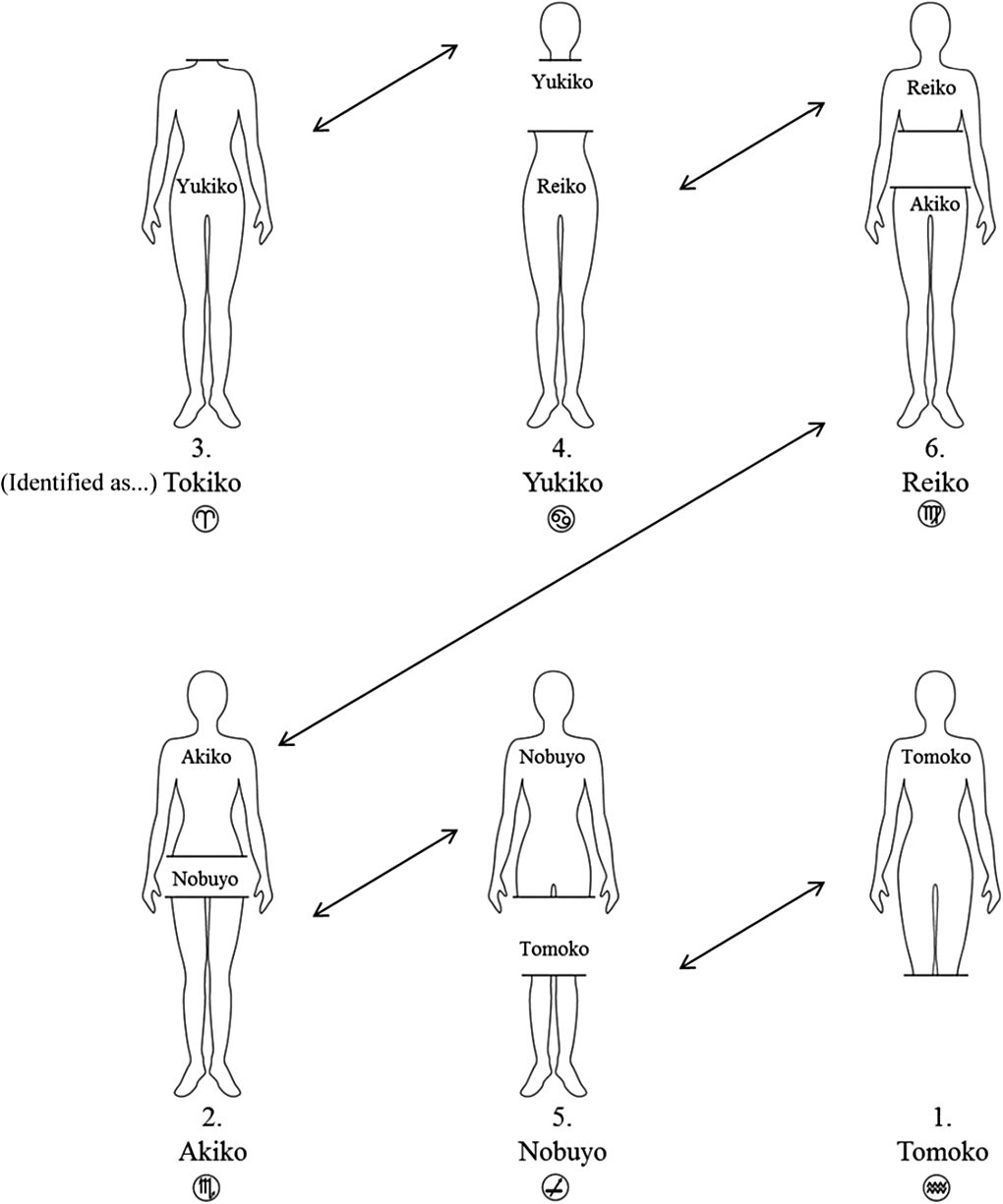
“As you can see here, with the exception of the first case, each ‘body’ actually consisted of the body parts of
two
different women. In each case, the combination of these body parts was identified—or misidentified—as being
one
person.
“Let me now show you how this is basically the same technique that was employed in the fraud committed with the ten-thousand-yen bills…
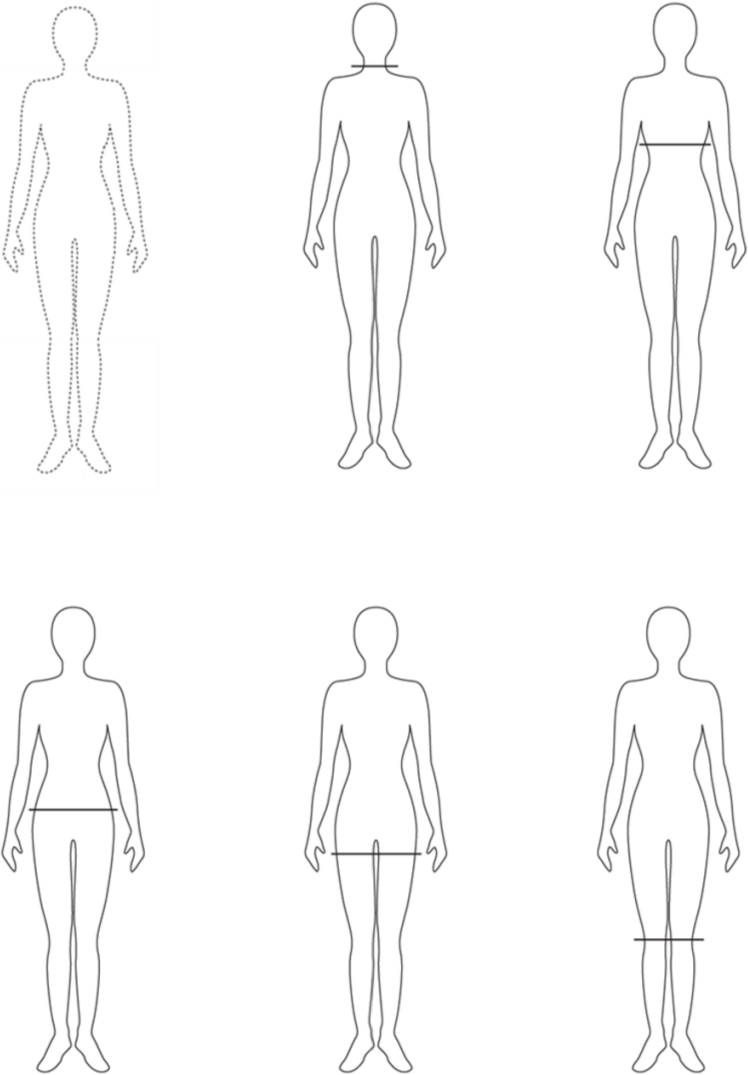
“The killer sawed through
five
bodies like this. Then the lower part of each body was buried together with the upper part of the adjacent body. At the end, you have the illusion of six bodies.
“In view of the gruesome nature of the deed and the tremendous effort involved, you may be surprised to hear it was carried out by one woman. Well, up to now, nobody ever doubted that the killer had had to saw through six bodies a total of ten times—twice for four of the bodies and once for two of them. In fact, the work was only half as strenuous because she only cut five bodies into ten pieces. Then she had to piece them together in the way I suggest here and dump them. Of course,
changing their clothes might have been a little troublesome, but the killer was obviously up to the task.
“Now, how about the locations where they were dumped? Well, obviously, if the six groups of body parts had been disposed of in one location, the killer’s method would have been readily apparent to investigators once they were discovered. In order to avoid this, she chose six very different places. Yes, that’s right,
she
chose the locations, not Heikichi!
She
was the one who wrote his note. I don’t think she believed in the astrological reasoning that she included in the note, because, as you can see, the upper and lower parts of the body of each woman were in fact buried separately in western
and
eastern Japan. But it was a very clever ploy indeed.
“As must now be clear, Taeko Sudo was one of the six women. And now I can reveal which one it was. The police were led to assume that she had died with the others and that the corpse without a head was hers. Yes, the one head never found belonged to… Tokiko. So she had to be the killer.”
There was a sudden silence. For a few moments we were all speechless.
“Then,” I said, “you mean that Taeko Sudo is, in fact…”
“Tokiko Umezawa.”
Again, there was a stunned silence as we tried to digest this revelation.
Kiyoshi allowed us a lengthy pause and then he said, very casually, “Well my friends, do you have any questions?”
Mr and Mrs Iida obviously had not been thinking about the case as much as I had; nor did they know Kiyoshi as well as I did. So I assumed the role of leader of the small and very confused group of listeners.
“First, about the depth of the burials…” I started. “The bodies that were believed to be Yukiko, Nobuyo and Reiko were found much later than the first three bodies because they were buried deeper. So that was deliberate?”
“Yes, indeed,” Kiyoshi replied. “That was exactly the point of the deeper burials: to delay the time of discovery. Here we can observe the brilliance of Tokiko. She arranged for the first three bodies to be found in the spring; the heat of summer was approaching, so the bodies would be cremated soon after. So when the other three bodies were found, the police would not have the first three corpses to compare them with. If they had had all six bodies they might have compared the surfaces of all the cuts and discovered the exact combination—although the clothing might have impaired their judgement. Needless to say, this trick would not have worked in any country where bodies are buried rather than cremated.
“Tokiko chose Tomoko’s body to be found first, because it really was Tomoko’s, although missing her lower legs and feet. It would be identified as Tomoko right away. That’s why it was left on the ground—to facilitate discovery. On the other hand, the body identified as Tokiko was in fact Yukiko’s—without her head. Tokiko knew that a headless body would be subject to very careful examination, so she arranged for it to be found later—but not the last. If Tomoko was found first, Akiko and Tokiko would probably be next, followed by Yukiko, Nobuyo and Reiko. That was the desired sequence because by the time the last three bodies were discovered, the sawed body parts would have rotted and they would be more or less reduced to skeletons.
“The segmentation and sequence would work very effectively, because either the upper or lower part of each victim would
have been cremated before the rest of her body was discovered. And the investigators wouldn’t realize that the combination of upper and lower body parts was wrong, even if the first three bodies found were put together in one place.
“Yukiko’s body—which was misidentified as Tokiko’s—was not deeply buried. But the body parts identified as Yukiko’s were buried very deep. That’s how the fraud was achieved.”
“How did Tokiko ensure that Yukiko’s body would be misidentified as her body?” I asked next.
“Well, Yukiko’s feet had been disfigured from years of ballet dancing; that was one point for identification, but it wouldn’t be sufficient. So Tokiko cleverly prepared false evidence. In Heikichi’s note she described herself as having a birthmark; in fact, it was Yukiko who had the birthmark on the right side of her stomach. Tokiko contrived to create a similar mark on herself and presumably showed it to her mother so that she would later be able to identify her. Yukiko’s body was not deeply buried so that it would be discovered while the birthmark and the disfigured toenails were still recognizable; and, sure enough, Tae misidentified the body as her daughter’s.
“There was the risk posed by Yukiko’s mother, Masako, who naturally would have known about Yukiko’s birthmark. Therefore, it was important that Masako wasn’t allowed the opportunity to identify either the body with the birthmark or the body buried with Yukiko’s head—which was, in fact, Reiko’s. Masako would immediately have spotted the deception. So Yukiko’s body had to be buried deep.
“By the time Yukiko, Nobuyo and Reiko were found decomposed, Masako had been incarcerated as a suspect. In prison, she must have become deranged. The police would not take her
ravings seriously. They would not let her see the body found with Yukiko’s head for identification, certainly not when it was badly decomposed. And Yukiko’s actual body was cremated as Tokiko without being shown to Masako.
